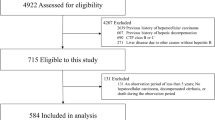Abstract
Purpose
The aim of this study was to assess splenic volume and to correlate unidimensional measurements with reference volumetric changes in chemotherapy-treated patients with colorectal cancer (CRC) liver metastases.
Methods
Forty consecutive patients were selected from the cohort of a previously reported study of chemotherapy-related morbidity following major hepatectomy for CRC liver metastases. Patients were treated for 6 months prior to resection, with imaging performed at baseline and after 6 months of chemotherapy. Three unidimensional spleen measurements were recorded—width, thickness, and height (W, T, and H). Reference splenic volume was measured at baseline and after chemotherapy. The best unidimensional splenic measurement was determined by regression analysis. The 95% CI for the predicted values and R 2 values was calculated for each regression. The percentage of volume increase at 6 months was calculated.
Results
W and H showed the highest correlation with splenic volume prior to and following chemotherapy (R 2 = 0.65–0.74, p < 0.001), while T showed a low correlation (R 2 = 0.11 and 0.18, p < 0.05). The mean reference splenic volume increased after 6 months of chemotherapy compared to baseline (326 vs. 278 mL). Splenic volume changes showed the highest correlation with changes in W (R 2 = 0.56, p < 0.001), then H (R 2 = 0.40, p < 0.001), but were not significantly correlated with changes in T (R 2 = 0.01, p = 0.055).
Conclusions
Our results show the potential utility of measuring changes in splenic width to predict clinically significant changes in splenic volume in chemotherapy-treated patients with CRC liver metastases.






Similar content being viewed by others
References
Overman MJ, Maru DM, Charnsangavej C, et al. (2010) Oxaliplatin-mediated increase in spleen size as a biomarker for the development of hepatic sinusoidal injury. JCO 28(15):2549–2555
Angitapalli R, Litwin AM, Kumar PR, et al. (2009) Adjuvant FOLFOX chemotherapy and splenomegaly in patients with stages II-III colorectal cancer. Oncology 76:363–368
Jung E, Ryu CG, Kim G, et al. (2012) Splenomegaly during oxaliplatin-based chemotherapy for colorectal carcinoma. Anticancer Res 32:3357–3362
Arakawa Y, Shimada M, Utsunomiya T, et al. (2014) Bevacizumab improves splenomegaly and decreases production of hyaluronic acid after L-OHP based chemotherapy. Anticancer Res 34:1953–1958
Robertson F, Leander P, Ekberg O (2001) Radiology of the spleen. Eur Radiol 11:80–95
Arkles LB, Gill GD, Molan MP (1986) A palpable spleen is not necessarily enlarged or pathological. Med J Aust 145:15–17
Linguraru MG, Sandberg JK, Jones EC, Summers RM (2013) Assessing splenomegaly: automated volumetric analysis of the spleen. Acad Radiol 20(6):675–684
Bezerra AS, D’Ippolito G, Faintuch S, Szejnfeld J, Ahmed M (2005) Determination of splenomegaly by CT: Is there a place for a single measurement? AJR 184(5):1510–1513
Pozo AL, Godfrey EM, Bowles KM (2009) Splenomegaly: investigation, diagnosis and management. Blood Rev 23(3):105–111
Lamb PM, Lund A, Kanagasabay RR (2002) Spleen size: how well do linear ultrasound measurements correlate with three-dimensional CT volume assessments? Br J Radiol 75:573–577
De Odorico I, Spaulding KA, Pretorius DH, et al. (1999) Normal splenic volumes estimated using three-dimensional ultrasonography. J Ultrasound Med 18:231–236
Prassopoulos P, Daskalogiannaki M, Raissaki M, Hatjidakis A, Gourtsoyiannis N (1997) Determination of normal splenic volume on computed tomography in relation to age, gender and body habitus. Eur Radiol 7(2):246–248
Simpson AL, Leal JN, Pugalenthi A et al. (2014) Chemotherapy-induced splenic volume increase is independently associated with major complications after hepatic resection for metastatic colorectal cancer. J Am Coll Surg
Wolf PS, Park JO, Bao F, et al. (2013) Preoperative chemotherapy and the risk of hepatotoxicity and morbidity after liver resection for metastatic colorectal cancer: a single institution experience. J Am Coll Surg 216(1):41–49
Kemeny N (2007) Presurgical chemotherapy in patients being considered for liver resection. Oncologist 12:825–839
Jarnagin WR, Gonen M, Fong Y, et al. (2002) Improvement in perioperative outcome after hepatic resection: analysis of 1,803 consecutive cases over the past decade. Ann Surg 236:397–406
Yetter E, Acosta KB, Olson MC, Blundell K (2003) Estimating splenic volume: sonographic measurements correlated with helical CT determination. AJR 181:1615–1620
Prassopoulos P, Cavouras D (1994) CT assessment of normal splenic size in children. Acta Radiol 35(2):152–154
Srisajjakul S, Prapaisilp P, Laorratkul N (2012) Normal splenic volume assessment on CT in 426 adults. Siriraj Med J 64(2):43–46
Larson SM, Tuell SH, Moores SH, Nelp WB (1971) Dimensions of the normal adult spleen scan and prediction of spleen weight. J Nucl Med 12(3):123–126
Picardi M, De Rosa G, Selleri C, et al. (2003) Spleen enlargement following recombinant human granulocyte colony-stimulating factor administration for peripheral blood stem cell mobilization. Hematologica 88(7):794–800
Frank K, Linhart P, Kortsik C, Wohlenberg H (1986) Sonographic determination of spleen size: normal dimensions in adults with a healthy spleen. Ultraschall Med 7(3):134–137
O’Reilly RA (1996) Splenomegaly at a United States county hospital: Diagnostic evaluation of 170 patients. Am J Med Sci 312(4):160–165
Acknowledgments
This research was partially funded by Grant numbers U54CA137788 and U54CA132378 from the National Cancer Institute (NCI) of the US National Institutes of Health (NIH), to the CCNY-MSKCC Partnership for Cancer Research Training & Community Outreach.
Conflict of interest
The authors declare that they have no conflict of interest.
Author information
Authors and Affiliations
Corresponding author
Rights and permissions
About this article
Cite this article
Joiner, B.J., Simpson, A.L., Leal, J.N. et al. Assessing splenic enlargement on CT by unidimensional measurement changes in patients with colorectal liver metastases. Abdom Imaging 40, 2338–2344 (2015). https://doi.org/10.1007/s00261-015-0451-7
Published:
Issue Date:
DOI: https://doi.org/10.1007/s00261-015-0451-7




